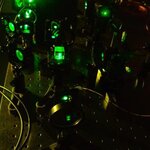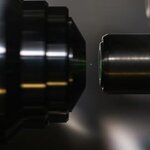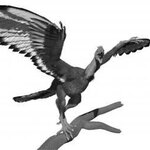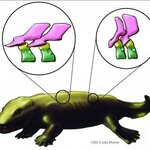Optics

Light traveling in a vacuum is the ultimate speed demon, moving at about 700 million miles per hour.
Matter cannot exceed the speed of light - unless, perhaps, there is a speed bump in light's path. Researchers from France's Université de Nice-Sophia Antipolis and China's Xiamen University have embedded dye molecules in a liquid crystal matrix to throttle the group velocity of light back to less than one billionth of its top speed. The team says the ability to slow light in this manner may one day lead to new technologies in remote sensing and measurement science.
The new…

Researchers have measured light emitted by photoluminescence from a nanodiamond levitating in free space.
Their paper describes how they used a laser to trap nanodiamonds in space, and – using another laser – caused the diamonds to emit light at given frequencies.
The experiment, led by Nick Vamivakas, an assistant professor of optics at the University of Rochester, demonstrates that it is possible to levitate diamonds as small as 100 nanometers (approximately one-thousandth the diameter of a human hair) in free space, by using a technique known as laser trapping. Specifically,…

Of the estimated 20,000 genes humans have, only a fraction are turned on at any given time. It depends on the cell's needs, which can change by the minute or hour.
Determining what those genes are doing means using tools that can manipulate their status on similarly short timescales and that is now possible with technology developed by the Eli and Edythe L. Broad Institute of Harvard and MIT. It can rapidly start or halt the expression of any gene simply by shining light on the cells.
The advance in optogenetics, which uses proteins that change their function in response to light, is…

X-ray experiments have found chemical traces of the original 'dinobird' Archaeopteryx and dilute traces of plumage pigments in a 150 million-year-old fossil.
Only 11 specimens of Archaeopteryx have been found, the first one consisting of a single feather. Until a few years ago, researchers thought minerals would have replaced all the bones and tissues of the original animal during fossilization, leaving no chemical traces behind, but two studies have turned up more information about this 'dinobird' and its plumage.
The first is the discovery of melanosomes; microscopic 'biological paint pot'…
My wife’s cousin, the break-dancing radiologist, broke the microphone clip off my mic stand while singing karaoke on Thanksgiving (my wife and I host Thanksgiving at our house for the family every year). I had another microphone clip and replaced it so we could continue with karaoke, but I decided to keep the broken pieces of the old clip for the junk drawer.
I had forgotten about it for a few weeks but eventually came across the pieces of the mic clip. I noticed that the clip, when it broke, had sheared off flush with the top of the cap that screws on to the mic stand, and in the center…

Engineers from the University at Buffalo engineers have created technology that could lead to breakthroughs in solar energy, stealth technology and other areas - but they had to catch some rainbows first.
Qiaoqiang Gan, PhD, an assistant professor of electrical engineering at the University at Buffalo, and a team of graduate students developed a "hyperbolic metamaterial waveguide," which is essentially an advanced microchip made of alternate ultra-thin films of metal and semiconductors and/or insulators. The waveguide halts and ultimately absorbs each frequency of light, at…

Scientists have created single layers of a naturally occurring rare mineral called tungstenite, or WS2, and the resulting sheet of stacked sulfur and tungsten atoms forms a honeycomb pattern of triangles that have been shown to have unusual light-emitting (photoluminescent) properties.
According to Mauricio Terrones, a professor of physics and of materials science and engineering at Penn State, the triangular structures have potential applications in optical technology; for example, for use in light detectors and lasers.
Terrones explained that creating monolayers -- single, one-…

In a comment on You, Andromeda, And The Largest Structure In The Universe, Mike Crow posted a picture of Andromeda, made from 40 hours of his exposure, 5 minutes at time, in his driveway.
My first thought was 'Why isn't there more light?' from such a long exposure and that naturally leads to a question you are going to get from your teenager once they are presented with the knowledge that the universe is 'infinite' and so are all those stars; if the universe is infinite and just one galaxy, our own Milky Way, has 50 stars for every person currently on earth, how can it ever get dark? Light is…

What was the backbone of early tetrapods, the earliest four-legged animals, like?
High-energy X-rays and a new data extraction protocol have allowed researchers to reconstruct the backbones of the 360 million year old fossils in exceptional detail. The results shed new light on how the first vertebrates moved from water onto land.
Tetrapods are four-limbed vertebrates,today represented by amphibians, reptiles, birds and mammals. Around 400 million years ago, early tetrapods were the first vertebrates to make short excursions into shallower waters where they used their four limbs for…

Synchrotron-based imaging techniques of a 50 million-year-old lizard skin have identified the presence of teeth which are invisible to visible light, demonstrating for the first time that this fossil animal was more than just a skin moult.
Researchers used Synchrotron Rapid Screening X-ray Fluorescence at the Stanford Synchrotron Radiation Lightsource in California to map the chemical make up of a rare fossil lizard skin - powerful x-rays enabled the team to map the presence of phosphorus from teeth in this ancient reptile.
The relative position of the phosphorous in the skin fossil…